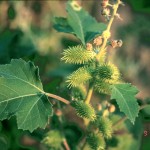Cocklebur
Xanthium strumarium L.
Asteraceae (Sunflower Family)
Description
Cocklebur is an introduced annual plant in the Sunflower family. It is a coarse, rough weed commonly found across Texas. This plant spreads rapidly around tanks and down draws when moisture is adequate for germination.
The leaves are toothed or lobed and are located alternately along the stem. Separate male and female flowers grow on the same plant, although both are inconspicuous. The male flowers occur in dense clusters on the ends of the stems; female flowers occur in the leaf axils.
Cocklebur fruits are conspicuous and covered with many spines. The fruit has two compartments, each containing a seed.
The plant's forage value for wildlife and livestock is poor, and cocklebur in the seedling stage is poisonous to livestock.
Habitat
Cocklebur is found throughout most of the United States. In dry regions, it is most common around water holes, playas, arroyos and disturbed areas.
Toxic Agent
Cocklebur poisons all classes of livestock. The toxic substance in the seeds is carboxyatractyloside, a glycoside causing hypoglycemia and massive liver damage. Although livestock generally do not eat the seeds, problems can occur when cattle are fed whole cottonseed or hay contaminated with cocklebur. The toxic agent remains present in the seedling through the cotyledon stage. The toxin concentration drops rapidly when the first true leaves appear. A toxic dose of seedlings is about 0.75 to 1.5 percent of the animal's weight. Seedlings are toxic even when dead and dry.
Signs of Livestock Ingestion
Signs generally occur 12 to 48 hours after cocklebur seedlings are eaten.
They include: General weakness; Depression; Unsteady gait; Rapid, labored breathing with a weak, rapid pulse; Subnormal body temperature with nausea and regurgitation.
Once the animal is down, it convulses, makes running motions with its legs or shows a marked curvature of the neck. Death usually occurs a few hours to 3 days after the first signs appear.
Management Strategies
Keep poisoned animals warm and give them large amounts of fatty substances. Cream, milk and mineral oil can be given by mouth, administered through a stomach tube to avoid producing inhalation pneumonia. Heart and respiratory stimulants are also recommended.
Poisoning usually occurs when many seedlings germinate after a rain or as water recedes in low-lying areas. Hazard is greatly increased when seedlings are commingled with desirable foliage. Do not feed supplements or hay on ground where seeds or seedlings are present.
Control cockleburs by aerial or ground broadcast application of 2,4-D at 1.0 pound a.i./acre before plants flower. Or, mix a 1 percent solution of 2, 4-D for individual plant treatments.
Cocklebur germinates after summer rains, so chemical application may be required more than once a year. Follow any chemical treatment with proper range and livestock management programs.
Any means of mechanical control that prevents the plant from producing seeds helps reduce the population of this annual plant. Concentrations of small seedlings can be burned with a hand-held propane burner.
Images
Plant Characteristics
Seed Type: Fruit/Berry
Duration: Annual
Stem Texture: Hairless/Smooth, Prickly, Spiny, or Thorny
Growth Habit: Forbs/Broadleaf
Leaf Shape
 : Simple with Pinnate or Parallel Venation
: Simple with Pinnate or Parallel Venation
Season: Warm
Distribution
 : 01 - Pineywoods, 02 - Gulf Prairies and Marshes, 03 - Post Oak Savannah, 04 - Blackland Prairies, 05 - Cross Timbers and Prairies, 06 - South Texas Plains, 07 - Edwards Plateau, 08 - Rolling Plains, 09 - High Plains, 10 - Trans-Pecos
: 01 - Pineywoods, 02 - Gulf Prairies and Marshes, 03 - Post Oak Savannah, 04 - Blackland Prairies, 05 - Cross Timbers and Prairies, 06 - South Texas Plains, 07 - Edwards Plateau, 08 - Rolling Plains, 09 - High Plains, 10 - Trans-Pecos
Distributions
Distribution refers to the ecological region in Texas that a plant has been found. You can also view a clickable map.
Book: Brush and Weeds of Texas Rangelands (B-6208), Toxic Plants of Texas (B-6105)
Collection: Brush and Weeds, Toxics
Livestock Affected: Cattle, Goats, Horses, Pigs, Sheep
Livestock Signs: Abnormal Heartbeat, Convulsions, Depression/ Weakness, Incoordination, Irregular Breathing, Sudden Death, Vomiting/Regurgitation








